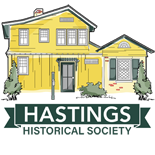In the mid-20th century, Hastings-on-Hudson had a series of village historians, most of whom operated independently out of their homes. A small group of Hastings residents felt that an entity devoted to preserving Hastings’ history was in order, so in 1961 several people got together to discuss the need for a historical society.
Although an organization did not come together then, around 1970 then-Mayor Sheldon Wagner was prevailed upon to hold a meeting of Hastings residents interested in forming a historical society. The Village offered the use of the courtroom on the second floor of the Municipal Building for meetings, and a portion of a nearby room for artifact storage. The New York State Board of Regents granted the Society a provisional charter on April 23, 1971, which is the official date of the Society’s inception. Outside of meeting times, the Society used the small storage area in the Municipal Building as its work space, which fondly became known as “the closet.”
The Society had a charter membership drive, which brought in more members than expected, and raised a substantial amount of money. In the early 1970s, Mrs. John Van de Water donated more than 1,000 negatives of photographs taken by her father, Dr. Arthur C. Langmuir, between 1920 and 1935. These became the core of the Society’s photo collection. Shortly thereafter, a newsletter was created to disseminate Village history to its members.

By 1983, then-President Karolyn Wrightson understood the Historical Society’s need for more space, both for archival storage and for work areas. Karolyn was a friend of Florence Levin’s, the curator of the Jasper Cropsey Studio on Washington Avenue, and knew that the home next door to the studio had been purchased by Mrs. Barbara Steinschneider Newington, the great granddaughter of famous Hudson River School artist Jasper Cropsey.
Florence encouraged Karolyn to talk to Mrs. Newington about use of the cottage for the Society. The newly purchased house was a modest 1850 cottage that had been owned by deceased Society member, Eleanor Whaley Rodgers, and had been built for an Irish mason who had worked on the building of the Croton Aqueduct. Soon after, Karolyn and Sue Smith arranged a meeting with Mrs. Newington where they explained the Society’s needs, and how the Whaley cottage could be the solution to the Society’s need for more space in order to grow as an organization.
Mrs. Newington offered the Society the use of the cottage for an annual rental fee of one dollar. She also promised to fund the renovation of the exterior to its original appearance. In return, the Society would outfit the interior for its own use, and pay for the utilities and upkeep of the building. A fundraising drive paid for the Society’s cost of upgrading the interior. At the same time, the goal of a $40,000 endowment was set, with the purpose of generating enough funds to maintain the building without becoming a burden on Society members. After renovations to the exterior, and volunteer work to prepare the interior, the Society held its inaugural event at the Washington Avenue cottage in April of 1986.

In late 1994, the Village offered the Society a long-term lease on the Observatory Cottage in Draper Park, which was built by Dr. Henry Draper to facilitate his explorations in astrophotography.
To renovate the Cottage and create a modern archive, the Society launched a $400,000 fundraising campaign. In 1996-97, renovations were completed and a beautiful new archive wing was added. In October of 1997, the Society and Dobbs Ferry-based architect Stephen Tilly were awarded the Lower Hudson Conference of Historic Services Award for Excellence in, “the interior restoration and adaptive archives addition to the Observatory Cottage.” Other, subsequent awards were bestowed upon the Society for the quality of its expanded Hastings Historian newsletter, the creation of its local history archives, and its Museum in the Streets® historical walking tour.
The new home of the Society was opened to the public on the weekend of November 8, 1997. Since that time, the Observatory Cottage and the Hastings Historical Society have been inexorably linked. From its humble beginnings in “the closet,” the Society is now happily ensconced in its historic home — caretakers to an extensive artifact collection and 12,000+ photo archives related to Hastings’ history.







